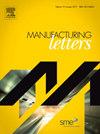用于机床数字双胞胎热误差补偿的卡尔曼滤波器驱动状态观测器
IF 1.9
Q3 ENGINEERING, MANUFACTURING
引用次数: 0
摘要
持续减少生产过程中的热误差是现代高精密制造面临的主要挑战。数值补偿模型提供了一种高能效的解决方案,但在数据驱动模型的情况下,高质量的实验数据必须耗费大量时间和成本,从而对整体生产率产生负面影响。此外,在出现新的运行条件时,也会出现鲁棒性问题,而这些条件并不包含在训练数据中。本文介绍了卡尔曼滤波器与模型阶次降低的有限元模型相结合的一种新方法,用于观察整个热状态,从而可以在不需要任何训练数据的情况下,纯粹根据物理系统模型对机械模型和热误差进行实时求解和计算。通过在热试验台上使用 40 个温度传感器中的 16 个进行观察,并在使用 25 个温度传感器中的 13 个进行观察的五轴机床 (MT) 上进行演示,对这种方法的有效性进行了评估。由于结合了降阶模型和卡尔曼滤波器,这 13 个温度传感器足以代表超过 350'000 个元素的 MT 网格。通过重建热试验台的整个温度曲线,未观测到的温度传感器的均方根误差(RMSE)仅为 2.7 °C,占所有温度变化的 83% 以上,五轴 MT 的均方根误差为 1.3 °C。热试验台的热误差均方根误差可从 67.4μm 减小到 33.3μm,相当于减少了 52.7%。在基于物理的实时模型中,无需实验数据进行模型校准即可实现这一目标。本文章由计算机程序翻译,如有差异,请以英文原文为准。
Kalman filter-driven state observer for thermal error compensation in machine tool digital twins
Sustainable reduction of thermal errors during production is the key challenge in modern high-precision manufacturing. Numerical compensation models provide an energy-efficient solution, but in the case of data-driven models, high-quality experimental data must be time-consuming and expensive to produce, negatively impacting overall productivity. Furthermore, robustness concerns arise in the case of new operating conditions, which were not contained in the training data. This paper presents a novel use of a Kalman filter together with model order reduced finite element models to observe the entire thermal state, which allows the subsequent solution of the mechanical model and computation of the thermal errors in real-time without requiring any training data but instead purely based on the physical system model. The effectiveness of this approach is evaluated using experiments on a thermal test bench with 16 out of 40 temperature sensors employed for observation and demonstrated on a 5-axis machine tool (MT) with 13 out of 25 temperature sensors used. Due to the combination of the reduced order model and Kalman filter these 13 temperature sensors are sufficient to represent a MT mesh of more than 350’000 elements. The entire temperature profile of the thermal test bench is reconstructed to achieve a root mean square error (RMSE) of the unobserved temperature sensors of only 2.7 °C, which accounts for more than 83% of all temperature variations and 1.3 °C for the 5-axis MT. For the thermal error of the thermal test bench, the RMSE could be reduced from to , corresponding to a reduction of 52.7 %. This could be achieved without the need for experimental data for model calibration, in a real-time capable physics-based model.
求助全文
通过发布文献求助,成功后即可免费获取论文全文。
去求助
来源期刊

Manufacturing Letters
Engineering-Industrial and Manufacturing Engineering
CiteScore
4.20
自引率
5.10%
发文量
192
审稿时长
60 days
 求助内容:
求助内容: 应助结果提醒方式:
应助结果提醒方式:


